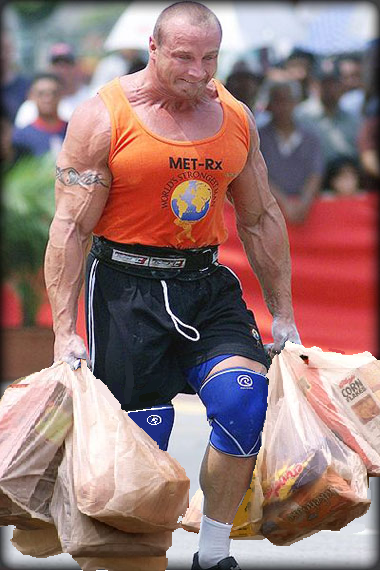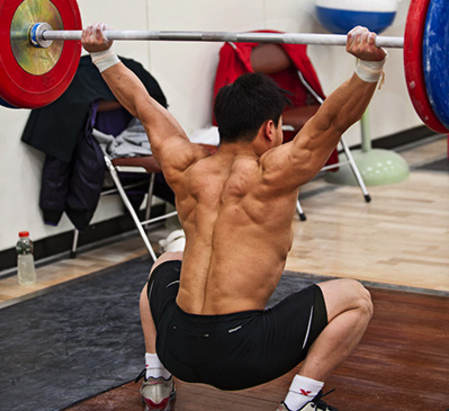Mash Mafia is celebrating Christmas and the Holidays with the “12 Days of Christmas” Holiday Specials. Here’s what you get:
and
– Free Domestic Shipping for all of our New Apparel

Check out all the savings here: ==> 12 Days of Christmas Holiday Specials
Insight on the low Back: Asymmetries is Where it All Begins

In 2004 I was diagnosed with two herniated discs, and I was told to retire from all competitive strength sports. I was faced with two options:
1. Quit even though I was 70lb from breaking the all-time total record.
2. Learn as much about the back as possible and take matters into my own hands.
Obviously I chose option 2. After researching the leading back people in the world, I landed on Dr. Stuart McGill. He is not only a leading researcher, but he also puts out work that is easily understood by us lesser academic mortals.
I also found Dr. Lawrence Gray of Gray Chiropractic and Sports Associates to be my weekly practitioner. Dr. Gray is on the same page as Dr. McGill, so it was a great fit. Dr. Gray kept me as balanced as a possible, and with the help of Dr. McGill’s work I started bulletproofing my core.
Rebecca Gerdon, Malcolm Moses-Hampton and I came out with the E-Book “No Weaknesses” regarding all the intricacies that we use for recovery. I am known as the guy that can get you strong, and now I want to be known as the guy that can keep you strong. Let’s face it! The person that can train the longest without major injury wins the game in the end.
I started working on recovery for the back. Obviously the first place that I started was Dr. McGill’s work. As I research I always like to pass on the information to you guys. Not only does it help you guys learn, but it also helps me retain the information.
Today I want to talk about asymmetries. Most practitioners want to talk about pain and range of motion to diagnose and predict back injuries. However, asymmetries in movement and strength are the first place to look because studies have shown that asymmetries in movement (especially in the hips) and strength in the low back is the number one way to diagnose and predict back injuries.
Think of the spine as a wall holding up your roof. If anything pulls the base of the wall in any direction, the wall is going to want to collapse. The balance of the low back and pelvis region is critical for low back health.
If your range of motion, function, or strength in the hips varies from right to left or front to back, I suggest working on mobility and finding a practitioner like Dr. Gray to assist in the process. Asymmetrical strength work should be a staple in everyone’s training. I suggest the following exercises:
1. Unilateral Bottom Up Kettlebell Carries: Instead of KB carries with the bell tucked against the wrist, hold the KB with the bell straight up in the air. Dr. McGill’s studies in his lab showed much more recruitment of the quadratus lumborum and abdominal obliques, which are crucial for hip movement and back and hip strength.

2. Traditional Farmers Walk
3. Traditional Kettlebell Carries
4. Unilateral Fat Grip Dumbbell Overhead Carries
5. Staggered Kettlebell Carries- one kettlebell is held overhead and the other down by the side.
6. Unilateral Farmers Walk
7. Axle Bar Zercher Carries
8. Sled Pushes
9. One arm sled drags
10. Deficit Suitcase Deadlifts
If you visit the Mash Compound, you will see one of these versions being used by our athletes. Our athletes are taking a long-term view to their training. We have a young team, so we are thinking not just the next Olympics but also the next two or three. I hope that you will too.
I love how Dr. McGill turns his corrective exercises into performance enhancers. The same carries mentioned above not only help to stabilize the spine, but they also give athletes the power to absorb and transfer force. Unilateral carries are great for any athlete that needs to plant off one foot and change direction. This could be a football player making a cut, or a boxer planting and throwing the knockout overhand right.
Last night I had the honor of podcasting with Dr. McGill. It’s safe to say that he blew us all away with his knowledge bombs. Let me give you one nugget that should encourage you to make some shifts in your training. Here goes:
Proximal stiffness equals distal movement and athleticism. Here’s an example. Let’s look at the jerk. If an athlete is able to maintain complete stiffness in the torso during the dip and drive, this will lead to maximal force distributed up through the barbell with the arms moving at maximal velocity to lockout.
You could also look at the swing of a bat. If the athlete is able to maintain maximal stiffness in the core/torso, this will lead to maximum bat velocity. If the core/torso gives in any way, there will be power leakage. That’s why optimal torso/core training is critical for all athletes in performance and injury prevention.
“No Weaknesses” was a blast to research and develop. I believe that it could be a fantastic tool for all of you to avoid injury and to maximize performance. However, after last night’s podcast, I plan on doing even more research. I know that weightlifters, powerlifters, and all athletes could benefit from more resources regarding muscular balance and proper core stability.
You guys are going to love the podcast with Dr. McGill. I encourage you to listen to the podcast with a pen and paper. There are going to be a lot of misconceptions about core training revealed in the podcast. Some of you might get upset, and some of you will learn a better course of action. Either way you are going to learn and enjoy this lecture from the most interesting man on earth, Dr. Stu McGill.
If you don’t want to miss this podcast, get signed up for our newsletter and receive the FREE E-Book, “The Big Six”. Sign up below to get your Free E-Book and to never miss a podcast or article.
⇒ Receive the E-Book “The Big Six” for Free and keep up to date on podcasts and articles.
Mash Mafia is celebrating Christmas and the Holidays with the “12 Days of Christmas” Holiday Specials. Here’s what you get:
and
– Free Domestic Shipping for all of our New Apparel

Check out all the savings here: ==> 12 Days of Christmas Holiday Specials

Great article Travis! I’ll be implementing it tomorrow morning, bright and early! My athletes and I thank you.
I’m 43 and recently found out I have two partially torn discs. They are not herniated yet but doable me enough that I had to stop “loading weight” on my spine. I miss the bar so much and am hopeful there is a way back. Pun intended. I will be following how you recovered so perhaps I can help myself back to lifting!
I’m 43 and recently found out I have two partially torn discs. They are not herniated yet but disable me enough that I had to stop “loading weight” on my spine. I miss the bar so much and am hopeful there is a way back. Pun intended. I will be following how you recovered so perhaps I can help myself back to lifting!
“Asymmetries IS Where it All Begins” is improper grammar
Pingback: Dr. Stuart McGill and Brian Carroll on the Gift of Injury – The Barbell Life 188 – Mash Elite Performance